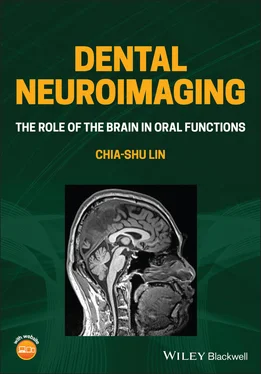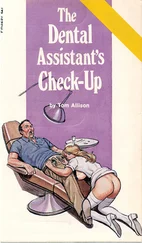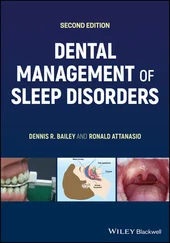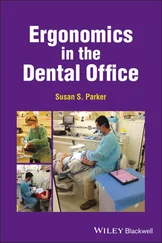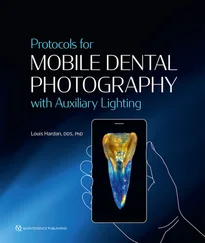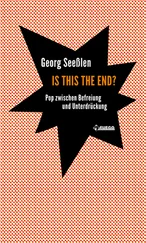26 Lund, J.P. (1991). Mastication and its control by the brain stem. Crit. Rev. Oral Biol. Med. 2: 33–64.
27 Luraschi, J., Korgaonkar, M.S., Whittle, T. et al. (2013). Neuroplasticity in the adaptation to prosthodontic treatment. J. Orofac. Pain 27: 206–216.
28 Lynch, C.D., O'Sullivan, V.R., and McGillycuddy, C.T. (2006). Pierre Fauchard: the 'father of modern dentistry'. Br. Dent. J. 201: 779–781.
29 MESH (1969). Feeding Behavior [Online]. Available: www.ncbi.nlm.nih.gov/mesh/68005247[Accessed 2021].
30 MESH (1986). Stomatognathic System [Online]. Available: https://www.ncbi.nlm.nih.gov/mesh/68013284[Accessed 2021].
31 MESH (2012). Neuroimaging [Online]. Available: https://www.ncbi.nlm.nih.gov/mesh/68059906[Accessed 2021].
32 Moayedi, M., Weissman‐Fogel, I., Salomons, T.V. et al. (2012). White matter brain and trigeminal nerve abnormalities in temporomandibular disorder. Pain 153: 1467–1477.
33 Nakamura, Y., Goto, T.K., Tokumori, K. et al. (2011). Localization of brain activation by umami taste in humans. Brain Res. 1406: 18–29.
34 Ono, Y., Kobayashi, G., Hayama, R. et al. (2015). Prefrontal hemodynamic changes associated with subjective sense of occlusal discomfort. Biomed. Res. Int. 2015: 395705.
35 Onozuka, M., Fujita, M., Watanabe, K. et al. (2002). Mapping brain region activity during chewing: a functional magnetic resonance imaging study. J. Dent. Res. 81: 743–746.
36 Ozdiler, O., Orhan, K., Cesur, E. et al. (2019). Evaluation of temporomandibular joint, masticatory muscle, and brain cortex activity in patients treated by removable functional appliances: a prospective fMRI study. Dentomaxillofac. Radiol. 48: 20190216.
37 Quintero, A., Ichesco, E., Myers, C. et al. (2013). Brain activity and human unilateral chewing: an FMRI study. J. Dent. Res. 92: 136–142.
38 Sessle, B.J. (2019). Can you be too old for oral implants? An update on ageing and plasticity in the oro‐facial sensorimotor system. J. Oral Rehabil. 46: 936–951.Thulborn, K.R., Waterton, J.C., Matthews, P.M., Radda, G.K. (1982). Oxygenation dependence of the transverse relaxation time of water protons in whole blood at high field. Biochim Biophys Acta. 714(2): 265–270.
39 Taguchi, A., Miki, M., Muto, A. et al. (2013). Association between oral health and the risk of lacunar infarction in Japanese adults. Gerontology 59: 499–506.
40 Takahashi, T., Miyamoto, T., Terao, A., and Yokoyama, A. (2007). Cerebral activation related to the control of mastication during changes in food hardness. Neuroscience 145: 791–794.
41 Talbot, E.S. (1900). Limiations in dental education. J. Am. Med. Assoc. XXXIV: 1599–1600.
42 Telischak, N.A., Detre, J.A., and Zaharchuk, G. (2015). Arterial spin labeling MRI: clinical applications in the brain. J. Magn. Reson. Imaging 41: 1165–1180.
43 Tonsekar, P.P., Jiang, S.S., and Yue, G. (2017). Periodontal disease, tooth loss and dementia: is there a link? A systematic review. Gerodontology 34: 151–163.
44 Trulsson, M., Francis, S.T., Bowtell, R., and McGlone, F. (2010). Brain activations in response to vibrotactile tooth stimulation: a psychophysical and fMRI study. J. Neurophysiol. 104: 2257–2265.
45 Weissman‐Fogel, I., Moayedi, M., Tenenbaum, H.C. et al. (2011). Abnormal cortical activity in patients with temporomandibular disorder evoked by cognitive and emotional tasks. Pain 152: 384–396.
46 Wolpert, D.M. and Flanagan, J.R. (2016). Computations underlying sensorimotor learning. Curr. Opin. Neurobiol. 37: 7–11.
47 Xie, Q., Li, X., and Xu, X. (2013). The difficult relationship between occlusal interferences and temporomandibular disorder ‐ insights from animal and human experimental studies. J. Oral Rehabil. 40: 279–295.
48 Younger, J.W., Shen, Y.F., Goddard, G., and Mackey, S.C. (2010). Chronic myofascial temporomandibular pain is associated with neural abnormalities in the trigeminal and limbic systems. Pain 149: 222–228.
49 Youssef, A.M., Gustin, S.M., Nash, P.G. et al. (2014). Differential brain activity in subjects with painful trigeminal neuropathy and painful temporomandibular disorder. Pain 155: 467–475.
Конец ознакомительного фрагмента.
Текст предоставлен ООО «ЛитРес».
Прочитайте эту книгу целиком, купив полную легальную версию на ЛитРес.
Безопасно оплатить книгу можно банковской картой Visa, MasterCard, Maestro, со счета мобильного телефона, с платежного терминала, в салоне МТС или Связной, через PayPal, WebMoney, Яндекс.Деньги, QIWI Кошелек, бонусными картами или другим удобным Вам способом.
